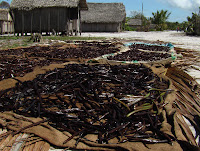I'm walking steadily along a red earth track, it's colour intensified by both sun and heat under the blue gaps in the heavy grey and white clouds. The damp sponginess of the red clay feels soft beneath the rubber of my shoes and the humidity is steadily tugging the sweat from my body as I strain under the weight of my rucksack. In the near distance I hear the familiar and jovial quacks of a family of ducks, and a warm smile pulls my face into shape, so that my expression is ready for the upcoming encounter. The merry sound of the quacking ducks and honking geese softens my heart as though I'm returning home after a long absence. In reality I am nowhere near my actual home. In 100 meters I enter a typical Malagasy rural village, and around me are children - snot-nosed and playfully running around in the moist red dust - and they gather in bunches shouting 'Salut Vazaha!' (Greetings Foreigner) at the very top of their voices. Among the children and wooden huts, there are chickens scratching away at the dirt for errant grains of rice, proud geese strutting around like they own the entire village (and beyond), and the friendly faces of adults and children alike will first stare and then light up into a glowing smile as I greet them back. "Salut Gasy!' I reply, and they stare, fascinated and giggling with mirth.




Trekking in the Sava and Masoala regions of Madagascar takes on a rhythm characterised by the above experience, but nothing can prepare you for the heady fragrance that inevitably catches you by surprise as you walk through the village, like walking into a wall of sweetness. Towards the centre of the village, a slightly metallic and sensory delectableness of prepared vanilla hits me like a blast of warm air, sensual, lusty, and every time I encounter it seems like first time!
Statistics claim that Madagascar (with Reunion and Comoros) produces something like 80% of the world's vanilla, and most of it is exported to the USA and Europe for ice cream production. It is also one of the main commodities produced in the very fertile SAVA region, others being rice, coffee, banana's, bread fruit, mangoes, coconuts, jackfruit, and others. The beautiful aroma of vanilla pods drying in the villages near where they grow is incongruous with the shiny and chocolaty brown pods that I see on the grass mats outside many of the village dwellings.


Speaking to the local farmers, they gladly describe to me the lengthy process and the years of effort and skill required to cultivate and prepare this commodity - very little of which is used locally, simply because it's value on the international market more than outweighs any opportunities for local consumption. A host plant, such as jatrofa must be prepared and planted, in just the right soil, with just the right aspect, and just the right amount of sun and shade to accommodate the vanilla vines. Lengths of vine are hand-planted individually at the base of the host, and after a few years (if not taken by disease) will begin producing the green beans. Pollination is by hand only, and each flower must be pollinated individually.

When the beans are ripe, they are hand picked and gathered. Soon they must by boiled in a specially constructed basket in a large cauldron over a wood fire for an exact number of minutes. On removal from the boiling water they are hurriedly wrapped in insulating material and put away for 2 days so that they remain at a high temperature. They must then dry in doors for some time before they can be laid out to dry in the sun. A year later they are dry enough to be sold to the co-operatives or transported to the nearest town. Bundles are individually prepared and each pod is massaged and stretched like a stiff muscle before it is bundled.
Such is the effort that gets put into preparing this bean which is then used in luxury food items.
Many stories and situations accompany these plump, sliverry shiny beans:
1) I met a vanilla farmer who, taking a break from stretching sinuous pods in his hand walked up to me and shook my hand. A few minutes later I lifted my hand to remove my hat, only to catch a whiff of the sweet aroma. Examining my hand I saw tiny little black specks, and realised that I had received my first authentic vanilla shake!
2) An English speaking student in the town of Sambava told me of the town thieves who prey on Vanilla merchants at night using their fine sense of smell.
3) Another Malagasy told of the dodgy Vanilla co-operatives who fill the pods with nails to bulk up the weight that they are sold at.
4) In books at tourist venues I found recipes for canard a la vanille (Vanilla duck), and in one fancy restaurant in Tana I had the most delectable meal of grilled fish in a creamy vanilla sauce.
5) Shops everywhere sell the delicious Malagasy vanilla yogurt in their plastic returnable cups, sweet and full of little black specks that I first mistook for dirt and refused to eat it!
6) Another NGO worker told me that farmers will destroy all their food crops to plant vanilla when the international price is soaring, and who then become destitute when the price falls again.
7) It felt decadent to be able to buy several large, heavy bundles directly from the farmers at a tiny fraction of the price it is sold in Antananarivo, let alone the price you'll pay for a dried out sliver in my local deli or speciality store in Cape Town.
And that is a short story of my encounter with this mysterious and notorious bean of the Red Island.
Stephen








